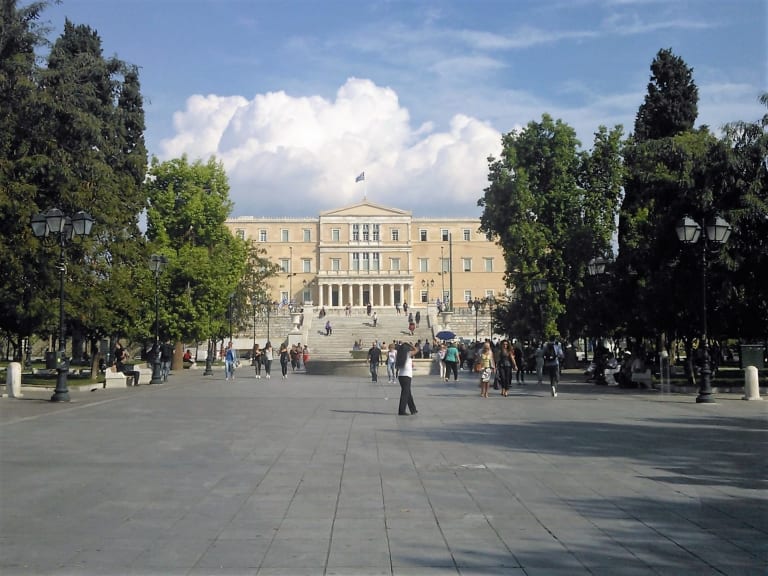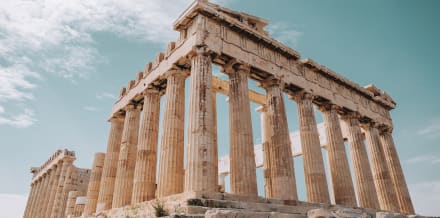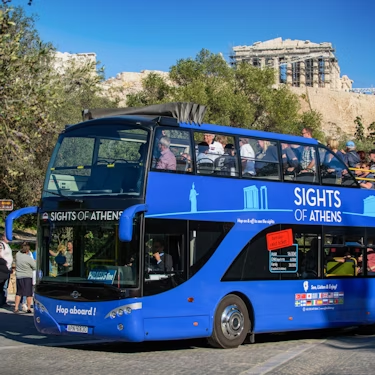More about: Best Things to Do In Athens In 3 Days
Athens is undoubtedly one of Europe' s most historic capitals and one of the most attractive places to visit in Europe. Visit archaeological museums, take day trips to the Greek islands, taste delicious traditional food and much more!
If you want to start your three-day stay in Athens on the right foot, before arriving at Athens airport I recommend you check out the best ways to get from the airport to your hotel. This way, you will avoid the long queues to get a taxi and choose the option that best suits your pocket.
Follow me and I will tell you the ideal itinerary so that you can do the best activities in Athens and not waste a single minute of your stay. Let's get started!
Day 1: Start your trip with a visit to the Acropolis and the historic centre of Athens

Who hasn't dreamt of seeing the Parthenon of the Acropolis and having their photo taken there? On your first day in Athens, make the most of it and visit the Parthenon along with the neighbourhoods of the historic centre. The itinerary is designed so that you can do it all on foot.
Acropolis of Athens
To start the itinerary of your first day in the Greek capital, there is no better way to do it than visiting the mythical Athenian Acropolis. The Acropolis is located at the top of Athens and can be seen from any point in the city. At this monument you can see the famous Parthenon among other historic temples.
To enter you need to buy your ticket to the Acropolis. You can buy it in advance online and avoid the long queues at the ticket offices. Although if you are passionate about Greek history and mythology, my advice is to hire a tour to the Acropolis that includes the entrance ticket and a professional guide in English so you won't miss any detail of this journey.
Rocio's Traveller Tip
To enter the Acropolis I recommend the south entrance. You will avoid the crowds at the west entrance to the Monument.
During the summer the gates to visit the Acropolis are open from 08.00 to 18.00 hours and in winter from 07.00 to 17.00 hours. If you have decided to travel to Athens in summer, I recommend you to start your tour early in the morning as temperatures are usually higher than in Athens in winter and visiting this attraction usually takes 2 to 3 hours.
Ah! I forgot... adults over 65 years old, children from 0 to 5 years old and students from the European Union under 25 years old enter the Acropolis free of charge if they present the corresponding certificates.
Areopagus
Assuming you started your Acropolis tour at 8am, you should be done by 11am. You still have one more stop before lunch and a visit to the Areopagus becomes the perfect plan.
Located a few metres west of the Acropolis, walking down this hill you will be able to admire the incredible scenery including the ancient agora. If you're tired, you can rest for a moment here and take the perfect photos for your Instagram.
The Areopagus is also of great historical value. It was the centre where the Council of Athens met, which ruled on the rules governing the city and judged those accused of the most serious crimes.
Plaka
Heading down towards the south of the Areopagus, we come across the historic centre of the city, the popular district of Plaka. It is considered the oldest quarter of Athens and is undoubtedly the one that most captivates tourists. As you walk through the narrow streets of Plaka, you will notice that the façades of its houses seem to be frozen in time. They are marked by the neoclassical style of the 19th century.
Among other things to do in Plaka, you can sit down for a delicious Athenian meal and recharge your batteries to continue your itinerary. This neighbourhood is one of the favourite places for those who want to go on a Greek food tour.
Although the choices of restaurants to sit down for lunch are varied and some are more budget-friendly than others, on this occasion I am going to recommend one in particular: Daphne's Restaurant. Located at 4 Lisokratous Street, it is one of the most renowned restaurants in Athens and one of the best reviewed.
The average price of the main courses is 7 euros. If you choose this option, I suggest you make a reservation in advance as they tend to work with maximum capacity. You can do so through their website, their official social networks or by calling them.
Monastiraki

When you have finished your lunch at Daphne's Restaurant, or elsewhere, and you have a full belly and a happy heart, you can continue your first day in Athens by visiting the Monastiraki neighbourhood.
This neighbourhood, located next to Plaka, is a great place to buy a souvenir of your time in Greece. Monastiraki is characterised by being one of the main shopping areas of the city. The Monastiraki Flea Market is located in the main square, which has the same name as the neighbourhood.
In the stalls that make up the flea market you can find all kinds of items, and when I say everything, I mean literally everything: from books on ancient Greece to football shirts from the main Athens clubs. From my own experience, I recommend that before you buy something, you negotiate the price with the seller. This is a very common practice in this market and you can get good prices for real gems.
Tzistarakis Mosque
But it's not all buying and selling at Monastiraki. If you weren't thrilled with the bargains at the stalls in the square or if you bought something but want to learn more about the history of Athens, you can do so by visiting the Tzistarakis Mosque.
You can get there on foot as it is located next to Monastiraki Square. Built in 1759 by the then governor of Athens, Mustapha Agha Tzistarakis, it is a clear example of the Turkish influence on the city's culture.
It was built on top of old city buildings and a column that Governor Tzistarakis had broken from the Temple of Zeus for use in the mosque. This coincided with an outbreak of plague in Athens, which is why the popular imagination holds that the Temple of Tzistarakis is under a curse. Today it houses the Museum of Greek Folk Art.
Hadrian's Library
This library is located underneath the Tzistarakis Mosque, and is undoubtedly one of the most emblematic places to visit in Athens. It was built by the Roman Emperor Hadrian in 132 AD. Documents state that it was surrounded by 100 columns and was approximately 120 metres long and 80 metres wide.
In ancient times, in addition to storing **Hadrian'**s gigantic collection of books, this place was used by philosophers to gather to read, lecture and meditate on intellectual matters.
Over the years and under different governments, the original construction of the library has mutated and today it bears little resemblance to the original one. Nevertheless, it is a good place to visit because its ruins still contain a large part of Athenian history and Western culture.
Museum of Greek Folk Instruments
About 130 metres from Hadrian's Library, on Diogenous Street, is the Museum of Greek Popular Instruments. Your last stop for the day.
If you are passionate about music, a visit to this museum will fascinate you. It houses a collection of 1200 Greek stringed, wind and percussion instruments. Some of them are up to 5,000 years old.
And so that you can hear what they sound like, headphones are available which reproduce the sounds of the different types of instruments. Excellent!
Admission is free and the visit won't take long. It's a good way to end your first day in Athens.
Day 2: Visit Syntagma Square, the National Archaeological Museum, the Panathinaiko Stadium, and much more!

Since one day is not enough to get to know in depth the history of Greece and its many attractions, this second day aims to deepen the tour of the first day and show you other important sites that you can't miss.
Panathinaiko Stadium
The itinerary of the second day in Athens starts at the mythical Panathinaiko Stadium. It is located on Vasileos Konstantinous Street, in the Pangrati district.
The Panathinaiko is the only sports stadium in the world made entirely of white marble in the shape of a letter U. It was built in 329 BC by order of Lycurgus of Sparta, although it was later renovated several times.
It is also world famous for being the official venue of the first modern Olympic Games held in Athens in 1896. I recommend you bring your camera and take a photo of yourself on the podium with the Olympic flag emulating the ancient medallists.
To see the inside of the Panathinaiko you must buy a ticket. Adults pay approximately 10 euros, EU students 5 euros and children under the age of 6 are free. With your ticket, an English-speaking guide will take you around the stadium and briefly tell you about its history.
Temple of Olympian Zeus
Continuing your second day's walk, crossing Vasileos Konstantinous and Ardittou streets, you will come across the ancient Temple of Zeus. If you were shocked by the height of the Acropolis buildings, wait until you see this monument.
Its construction was completed in 131 AD by Emperor Hadrian. It had 104 Corinthian columns and was approximately 97 metres long and 39 metres wide. For many years it was the largest temple in the world.
Today there are only 15 of the original 104 columns, but what happened to the rest? It is not known for sure. It is believed that an earthquake in the Middle Ages devastated the monument leaving only those columns standing. Either way, I recommend that you take a walk around this iconic Athenian landmark and take some photos that you will treasure forever. Ah, and from the temple you will have the view of the Acropolis that you will have seen on your first day.
The monument is open every day from 8am to 3pm. Adults must pay approximately 12 euros and students with supporting documents 6 euros. Children under the age of 6 are free.
National Garden and Zappeion Park

Tired of concrete, marble and asphalt? A walk through the National Garden and Zappeion Park is the solution. To get to this park, if you are coming from the Temple of Zeus, just cross the street Leof. Vassilis Olgas Street.
The National Garden was created by Queen Amalia, wife of King Otto in 1838. Initially, Amalia had created this site for herself and her husband, the general public was not allowed access. By 1920 this had changed and it became the property of the entire Athenian society. Zappeion Park, meanwhile, was built in 1888 and was intended as the Olympic Village for the first modern Olympic Games. Nowadays it hosts various events and conferences from the world of sport, politics, economics, etc.
The National Garden and the Zappeion Park together cover approximately 24 hectares. Here you can see some 7000 trees, thousands of plants native to Greece, six lakes and as if that wasn't enough, a zoo! Believe me you won't regret this visit.
Admission to both parks is free. If you want to see the inside of Zappeion Park, I recommend that you first check the dates on their calendar of events and lectures to find out when they are available.
Syntagma Square
Leaving the National Garden, in front of it, is Syntagma Square. This is one of the most important squares in Athens, if not the most important, as it brings together the hectic social life of Athenians and their tourists, as well as the political life due to the fact that the Greek Parliament is just a few metres away.
The literal translation of Syntagma in English is "Constitution". In other words, Syntagma Square is Constitution Square. It is known by this name because it was here that the citizens of Athens forced King Otto to issue a constitution.
Syntagma undoubtedly holds the heart of the Athenians. It has been the site of massive celebrations as well as the toughest demonstrations.
In addition to the Greek Parliament, in this square you can see the Tomb of the Unknown Soldier. This tomb is guarded by two Athenian Evzones. And here comes the attraction why you should stay in Syntagma for a few more minutes: every 1 hour, you will be able to watch the enthralling changing of the guard of the Greek soldiers that brings together many of the tourists passing by. You can't miss it!
National Archaeological Museum
The itinerary of your second day in Athens ends at the National Archaeological Museum located at 44 Oktovriou Street.
This museum opened its doors in 1891 and is considered the most important and extensive museum in Greece. Its façade is in the neoclassical style predominant in the 19th century and inside it has more than 20,000 objects from Ancient Greece divided into 32 rooms. Among the exhibits you can see jewellery, sculptures and ceramics that were found in excavations throughout the country.
In addition, the National Archaeological Museum is organised into five sections that will help you not to get lost among so many objects and to be able to organise them chronologically. These sections are: Prehistory, Sculpture, Ceramics, Bronze and Egyptian Antiquities.
You can visit the museum from Monday to Monday. The approximate cost of admission is as follows:
- Adults: 10 euros.
- Non-European Union students and over 65s: 5 euros.
- Under 18s: free admission.
This plan is ideal to do at the end of your second day in Athens, as by that time you will be immersed in the history of the country and will have a better understanding of what you are seeing.
Day 3: Hop on a boat in Athens and cruise around the Greek islands of Hydra, Poros and Aegina

For your third day in Athens, I recommend you get on board a boat and visit the Greek islands. Now that you've seen the highlights of Athens, this is a great way to get out of the city and see these fabulous islands.
Day trips from Athens to the islands of the Saronic Gulf usually start early in the morning from Piraeus pier, which is a 35-minute metro ride from the centre of Athens. Most packages that offer this trip include a pick-up and drop-off service from your hotel and return to your hotel.
Once you are on board the ship, listen carefully to the crew's instructions and get ready to explore these islands in the crystal clear waters of the Mediterranean.
Hydra
This is the first island you will visit. When the ship docks, you will have approximately 2 hours of free time to explore the island. Hydrais one of the few places in the world where cars are strictly forbidden. The way to get around is to walk, use a bicycle or ride one of the hundreds of donkeys you will see on the island.
This island is characterised by its narrow cobblestone streets, red-tiled houses and celebrity summer mansions. My recommendation is to take a short walk and then take a dip in the crystal clear beaches.
Poros
On the way back to the boat you'll set off for Poros, your second destination. This island is the smallest of the three you will visit. It has a large vegetation and gigantic pine and lemon trees that perfume the whole island with their scent. In the free time you have in Poros I recommend you visit:
- Archaeological Museum of Poros.
- The Clock Tower.
Aegina
When you have finished visiting the island of Poros, you should board the boat that will take you to your last destination: the island of Aegina. On the way to the island you can enjoy a buffet lunch to recharge your batteries for your last stop.
The island of Aegina is the largest island in the Saronic Gulf and is renowned for the phenomenal beauty of its beaches. It is the ideal place for you to completely relax, sunbathe or if you prefer snorkelling, diving or water skiing.
On the boat that takes you to the island, you will also be offered a tour of the Temple of Aphaeatext which is a good option if you prefer to learn more about the history of the island.
Aegina is also home to some of the best pistachio nuts in the world. When you walk through the little streets of the island, you will be able to buy pistachio products in the local shops. Believe me, you won't regret trying them.
At the end of your stay on the island of Aegina, you should return to the boat that will take you to the pier of Piraeus. On board, you will enjoy a unique show of Greek musicians and dancers that will make your return much more enjoyable.
At the pier, you will be picked up by a shuttle and taken back to your hotel in Athens.
And that's the end of your three-day stay in Athens. Most of this itinerary was designed so that you can walk short distances and not waste too much time.
If you fell in love with this European capital (like me) and decide to come back, I recommend you to take an excursion to the island of Mykonos or book a few days to visit Meteora and Delphi.




